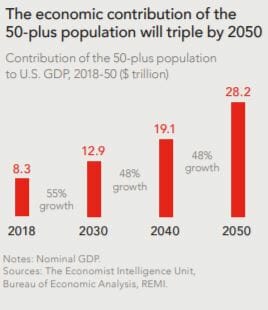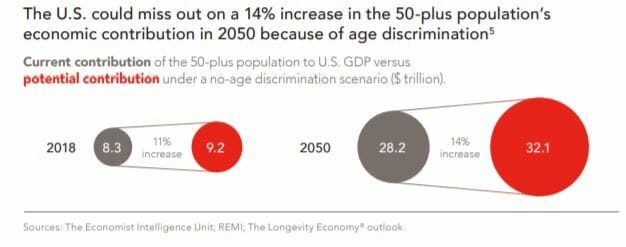New AARP report highlights How discriminating against older workers could cost the U.S. economy $850 billion

Age discrimination cost the U.S. economy a potential $850 billion in GDP in 2018
The AARP recently published a report that provides insight into the economic impact of failing to address age discrimination. Continue reading for key insights and access the full report HERE.
Executive summary and key insights
As people are living longer and in many cases healthier lives, the U.S. workforce is growing more age-diverse. There are 117.4 million people age 50-plus in the U.S., many of whom now plan to work well past the age of 65. This growing pool of workers represents a significant asset for businesses—and for the economy—as they possess valuable skills and experience. But age discrimination, manifest in workplace behaviors, attitudes, policies and procedures, is prevalent, limiting potential gains. This AARP study explores the foregone economic growth that could be generated if employers address age discrimination through better hiring practices and workplace retention initiatives.

The Longevity Economy® outlook
measures the 50-plus population’s
overall contribution to GDP,
employment, wages and salaries, and
taxes through 2050, and analyzes its
unique effect within different industries.
The economic contribution of people
age 50-plus was worth $8.3 trillion in
2018, and it is forecast to more than
triple to $28.2 trillion by 2050.6
The Economic Impact of Age
Discrimination looks beyond this
contribution to understand how
workplace and hiring discrimination
limits the 50-plus cohort from
generating additional value and from
realizing their full economic potential.
In 2018, the 50-plus population contributed 40% of U.S. Gross Domestic Product (GDP)—an outsized impact for a group that comprises just 35% of the population—and supported 88.6 million jobs and $5.7 trillion in wages and salaries, according to AARP’s Longevity Economy® outlook.
The economy missed out on an additional $850 billion to U.S. GDP in 2018—a figure the size of Pennsylvania’s economy— because of age discrimination. This gap could rise to $3.9 trillion in 2050.
All industries are impacted. Reducing involuntary retirement, underemployment, and unemployment duration among the 50-plus population could have driven an average increase of 4.1% in GDP in 2018. In 2050, an uplift of 6.0% could be generated. The technology and automotive manufacturing sectors have the most to lose in the future.

